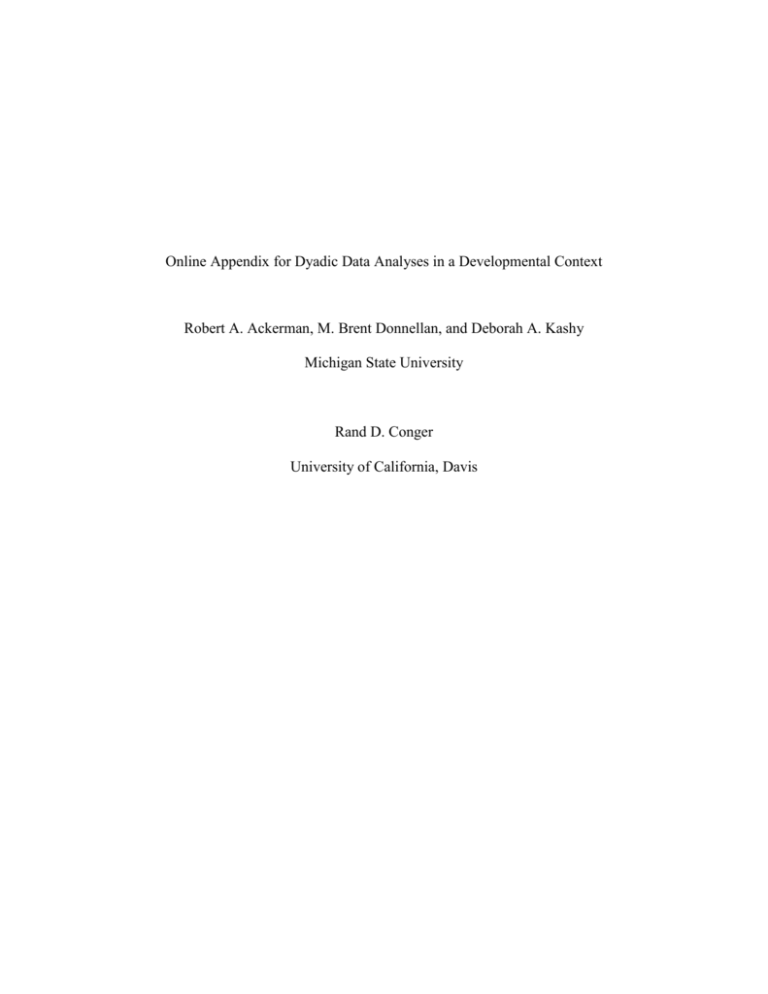Online Appendix
advertisement

Online Appendix for Dyadic Data Analyses in a Developmental Context Robert A. Ackerman, M. Brent Donnellan, and Deborah A. Kashy Michigan State University Rand D. Conger University of California, Davis Table A Example Data Structures Dyad Data Structure FamilyID MomNeuro ChildNeuro MomPosEng ChildPosEng 15 2.00 4.08 3.00 3.20 16 2.67 2.17 3.00 4.20 Individual Data Structure FamilyID Role Neuro PosEng 15 1 2.00 3.00 15 -1 4.08 3.20 16 1 2.67 3.00 16 -1 2.17 4.20 Pairwise data structure FamilyID Role ActNeuro PartNeuro ActPosEng PartPosEng 15 1 2.00 4.08 3.00 3.20 15 -1 4.08 2.00 3.20 3.00 16 1 2.67 2.17 3.00 4.20 16 -1 2.17 2.67 4.20 3.00 Note. Role: 1 = Mother,-1 = Child. ActNeuro = Actor’s neuroticism. PartNeuro = Partner’s neuroticism. ActPosEng = Actor’s positive engagement. PartPosEng = Partner’s positive engagement. Table A presents an example of these three data formats using dyadic data collected from a cross-sectional sample. Included in the table are scores from two families in which mothers are observed interacting with their child during a conflict resolution task. In the present example, we are interested in examining the relation between neuroticism and the expression of positive engagement. The top panel of Table A presents the dyad data structure in which the scores from both dyad members are represented on a single data record. The first column indicates dyad membership (i.e., FamilyID), the next two columns include the scores for mother’s and child’s neuroticism (i.e., the dispositional tendency to experience negative emotions like hostility, fear, and distress; MomNeuro, ChildNeuro), and the last two columns include the mother’s and child’s positive engagement scores (MomPosEng, ChildPosEng). Thus, the dyad data structure includes separate variables for the two dyad members’ scores on each measure. The middle panel of Table A presents the individual data format. In this data structure there is a single record for each individual in the study, and so each dyad has two records. Like the dyad data structure, there is a column indicating dyad membership (FamilyID). However, there is also an additional variable, role, that designates whether the record includes data from the mother (role = 1) or the child (role = -1). Because each individual has his/her own record, there are only two additional columns: one for the person’s score on neuroticism (Neuro), and the other for the person’s score on observed positive engagement (PosEng). The final panel of the table shows the pairwise data format. In this structure, there is a single record for each individual and each data record includes the FamilyID and role variables. Moreover, both dyad members’ scores are represented on each record. Thus, the pairwise data format represents a blend of both the individual and dyad data formats. In a pairwise data set a distinction is made between the actor and the partner. By convention, the actor is typically the dyad member who generated the observation and the partner is the other dyad member. In this example we now have a variable, ActNeuro, which is the neuroticism score for the mother if role = 1 and the child’s neuroticism score for records on which role = -1. A second variable, PartNeuro, refers to the child’s neuroticism score if role = 1 and the mother’s neuroticism score if role = -1. The same pattern holds for the two positive engagement scores: ActPosEng and PartPosEng. Table B Dyad Overtime Example for Distinguishable Dyad Members Famid T1BoyDistress T2BoyDistress T3BoyDistress T1MomDistress T2MomDistress T3MomDistress 1 1.27 2.14 1.83 1.08 1.33 1.40 2 1.86 2.08 1.14 1.49 1.27 1.70 3 1.57 1.16 1.00 1.60 1.84 1.24 4 1.10 1.09 1.00 1.36 1.30 1.03 5 1.23 1.03 1.46 2.17 1.41 1.20 6 1.03 1.00 1.42 1.08 1.11 1.45 Note. Famid = Family identification number. T1BoyDistress = Son’s psychological distress at Time 1. T2BoyDistress = Son’s psychological distress at Time 2. T3BoyDistress = Son’s psychological distress at Time 3. T1MomDistress = Mother’s psychological distress at Time 1. T2MomDistress = Mother’s psychological distress at Time 2. T3MomDistress = Mother’s psychological distress at Time 3. This data structure is very similar to a dyad data set in that each row includes observations for both members of the data. However, in the dyad overtime data set there are separate variables designating each person’s outcome at each point in time. Table C Person-Period Pairwise Example for Distinguishable Dyad Members Dyadi d Da y Perso n Gende r Arelsa t Prelsa t 1 1 1 1 2 1 Arelsat C Prelsat C ArelsatPast C PrelsatPast C 1 5.75 5.75 -.57 -.57 1 1 6.25 5.00 -.07 -1.32 -.57 -.57 3 1 1 6.75 6.50 .43 .18 -.07 -1.32 1 1 2 -1 5.75 5.75 -.57 -.57 1 2 2 -1 5.00 6.25 -1.32 -.07 -.57 -.57 1 3 2 -1 6.50 6.75 .18 .43 -1.32 -.07 2 1 1 1 5.00 4.50 -1.32 -1.82 2 2 1 1 5.25 5.75 -1.07 -.57 -1.32 -1.82 2 3 1 1 5.25 7.00 -1.07 .68 -1.07 -.57 2 1 2 -1 4.50 5.00 -1.82 -1.32 2 2 2 -1 5.75 5.25 -.57 -1.07 -1.82 -1.32 2 3 2 -1 7.00 5.25 .68 -1.07 -.57 -1.07 Note. Gender is coded as 1 for men and -1 for women. Arelsat = Actor’s relationship satisfaction. Prelsat = Partner’s relationship satisfaction. ArelsatC = centered value for actor’s satisfaction. PrelsatC = centered value for partner’s satisfaction. ArelsatPast = Actor’s lagged relationship satisfaction. PrelsatPast = Partner’s lagged relationship satisfaction. Table C presents three days of relationship satisfaction scores from both members of two dyads. The first row for each individual has that person’s raw current relationship satisfaction score (Arelsat), his or her partner’s current relationship satisfaction (Prelsat), those same variables after grand-mean centering (ArelsatC and PrelsatC), and missing values for the previous day’s values (ArelsatPastC and PrelsatPastC). The second row is then the first observation for which there are non-missing values for the lagged satisfaction variables. SPSS/PASW Syntax for Analyses The Standard APIM for Distinguishable Members—Interaction Model MIXED ActPosEng WITH ActNeuroC PartNeuroC role /FIXED= role ActNeuroC PartNeuroC role*ActNeuroC role*PartNeuroC /METHOD=REML /PRINT=SOLUTION TESTCOV /REPEATED=role | SUBJECT(FamilyID) COVTYPE(CSH). The first line instructs the program to run a mixed model that predicts the actor’s positive engagement score (ActPosEng) as a function of the actor’s centered neuroticism score (ActNeuroC), the partner’s centered neuroticism score (PartNeuroC), and the distinguishing variable (role). Note that because we are using the WITH statement, the predictors are treated as covariates rather than factors. The second line of syntax specifies the fixed effects in the model. In our example, the fixed effects include the distinguishing variable (role), the actor’s centered neuroticism score (ActNeuroC), the partner’s centered neuroticism score (PartNeuroC), the interaction between the actor’s centered neuroticism score and the distinguishing variable (role*ActNeuroC), and the interaction between the partner’s centered neuroticism score and the distinguishing variable (role*PartNeuroC). The third line of syntax specifies the estimation procedure for the model. In our example, we are using Restricted Maximum Likelihood, or REML. The fourth line of syntax instructs the program to provide us with parameter estimates for the model. The fifth line of syntax tells the program how to handle the nonindependence between dyad members’ observations and how to specify the error structure. By entering “/REPEATED=role”, we are instructing the program to treat each dyad member as a repeated measure. This permits the possibility of a negative covariance. The “SUBJECT(FamilyID)” statement specifies that persons are nested within family units (i.e., mother-child dyads). Last, the correlation between the unexplained variance in the outcome across dyad members, as well as separate estimates of the residual variances for mothers and children, are obtained by requesting “heterogeneous compound symmetry, correlation metric” using the SPSS/PASW command: COVTYPE (CSH). The Standard APIM for Distinguishable Members—Two-intercept Model MIXED ActPosEng WITH ActNeuroC PartNeuroC child mother /FIXED= mother child mother*ActNeuroC child*ActNeuroC mother*PartNeuroC child*PartNeuroC | NOINT /METHOD=REML /PRINT=SOLUTION TESTCOV /REPEATED=role | SUBJECT(FamilyID) COVTYPE(CSH). The first line instructs the program to run a mixed model that predicts the actor’s positive engagement score (ActPosEng) as a function of the actor’s centered neuroticism score (ActNeuroC), the partner’s centered neuroticism score (PartNeuroC), the dummy-coded variable used to denote child (child), and the dummy-coded variable used to denote mother (mother). Note that because we are using the WITH statement, the predictors are treated as covariates rather than factors. The second line of syntax contains the fixed effects for the model. Note that the intercept is suppressed in this analysis (i.e., the NOINT command in the FIXED statement). This specification is necessary to obtain separate estimates of the intercept for the mother (mother) and child (child). The remaining four terms in the FIXED statement involve interactions between the dummy variables and the actor or partner effects. Interactions with the mother dummy code refer to results for the mother’s outcomes. Likewise, interactions with the child dummy code refer to results for the child’s outcomes. The interaction between mother and ActNeuroC therefore provides an estimate of the actor effect for the mother. Similarly, the interaction between child and PartNeuroC provides an estimate of the effect of the mothers’ neuroticism on the children’s expression of positive engagement. The third line of syntax specifies the estimation procedure for the model. In our example, we are using Restricted Maximum Likelihood, or REML. The fourth line of syntax instructs the program to provide us with parameter estimates for the model. The fifth line of syntax tells the program how to handle the nonindependence between dyad members’ observations and how to specify the error structure. By entering “/REPEATED=role”, we are instructing the program to treat each dyad member as a repeated measure. This permits the possibility of a negative covariance. The “SUBJECT(FamilyID)” statement specifies that persons are nested within family units (i.e., mother-child dyads). Last, the correlation between the unexplained variance in the outcome across dyad members, as well as separate estimates of the residual variances for mothers and children, are obtained by requesting “heterogeneous compound symmetry, correlation metric” using the SPSS/PASW command: COVTYPE (CSH). The Cross-Lagged APIM for Daily Diary Data MIXED ASatisf WITH man woman ASATPreviousC PSATPreviousC /FIXED = man woman ASATPreviousC*man ASATPreviousC*woman PSATPreviousC*man PSATPreviousC*woman | NOINT /CRITERIA MXSTEP(50) /PRINT = SOLUTION TESTCOV /RANDOM = man woman ASATPreviousC*man ASATPreviousC*woman PSATPreviousC*man PSATPreviousC*woman | SUBJECT(DyadID) COVTYPE(UN) /REPEATED = Person | SUBJECT(DyadID*day) COVTYPE(CSH). The first line of syntax instructs the program to run a mixed model that predicts the actor’s current relationship satisfaction (ASatisf) to be a function of the dummy-coded variable to denote men (man), the dummy-coded variable to denote women (woman), the actor’s lagged satisfaction (ASATPreviousC), and the partner’s lagged satisfaction (PSATPreviousC). The second line of syntax contains the fixed effects for the model. Note that the intercept is suppressed in this analysis (i.e., the NOINT command in the FIXED statement). This specification is necessary to obtain separate estimates of the intercept for the men (man) and women (woman). The remaining four terms in the FIXED statement involve interactions between the dummy variables and the actor or partner effects. Interactions with the man dummy code refer to results for the men’s outcomes. Likewise, interactions with the woman dummy code refer to results for the women’s outcomes. The interaction between man and ASATPreviousC therefore provides an estimate of the average stability of relationship satisfaction for the men. Similarly, the interaction between woman and PSATPreviousC provides an estimate of the average effect of the men’s satisfaction the previous day on the women’s current relationship satisfaction. The fourth line of syntax instructs the program to provide us with parameter estimates for the model. The fifth line of syntax specifies the random effects for the model. Here we specify that we want random effects (or variances) for the men’s intercepts (man), the women’s intercepts (woman), the men’s actor effect (ASATPreviousC*man), the women’s actor effect (ASATPreviousC*woman), the men’s partner effect (PSATPreviousC*man), and the women’s partner effect (PSATPreviousC*woman). The “SUBJECT(DyadID)” statement informs the program that dyad members are nested within DyadID. Moreover, to specify an unrestricted variance-covariance matrix between all of the previously mentioned random effects, we enter “COVTYPE(UN)”. The last line of syntax tells the program how to handle the nonindependence between dyad members’ observations and how to specify the error structure. By entering “/REPEATED=Person”, we are instructing the program to treat each dyad member as a repeated measure. This permits the possibility of a negative covariance. The “SUBJECT(DyadID*day)” specifies that persons are nested within the interaction of DyadID and day. Last, the correlation between the unexplained variance in the outcome across dyad members, as well as separate estimates of the residual variances for men and women, are obtained by requesting “heterogeneous compound symmetry, correlation metric” using the SPSS/PASW command: COVTYPE (CSH). SAS Syntax for Analyses The Standard APIM for Distinguishable Members—Interaction Model PROC MIXED COVTEST; CLASS FamilyID; MODEL ActPosEng = role ActNeuroC PartNeuroC role*ActNeuroC role*PartNeuroC / SOLUTION DDFM=SATTERTH; REPEATED / TYPE=CSH SUBJECT= FamilyID; RUN; The PROC MIXED COVTEST command instructs SAS to run a mixed model and to print out tests of the variance-covariance parameter estimates. The CLASS command specifies FamilyID as the classification variable. The MODEL command specifies that we are predicting the actor’s positive engagement (ActPosEng) to be a function of the distinguishing variable (role), the actor’s centered neuroticism score (ActNeuroC), the partner’s centered neuroticism score (PartNeuroC), the interaction between the actor’s centered neuroticism score and the distinguishing variable (role*ActNeuroC), and the interaction between the partner’s centered neuroticism score and the distinguishing variable (role*PartNeuroC). In the MODEL command, we are also specifying via DDFM=SATTERTH that the degrees of freedom are estimated using the Satterthwaite approximation (see Kenny, Kashy, & Cook, 2006). Last, the REPEATED / TYPE=CSH SUBJECT= FamilyID command instructs the program how to handle the nonindependence between dyad members’ observations and how to specify the error structure. The SUBJECT(FamilyID) statement specifies that persons are nested within family units (i.e., mother-child dyads). The correlation between the unexplained variance in the outcome across dyad members, as well as separate estimates of the residual variances for mothers and children, are obtained by using the SAS statement: TYPE = CSH. The Standard APIM for Distinguishable Members—Two-intercept Model PROC MIXED COVTEST; CLASS FamilyID; MODEL ActPosEng = mother child mother*ActNeuroC child*ActNeuroC mother*PartNeuroC child*PartNeuroC / NOINT SOLUTION DDFM=SATTERTH; REPEATED / TYPE=CSH SUBJECT=FamilyID; RUN; The PROC MIXED COVTEST command instructs SAS to run a mixed model and to print out tests of the variance-covariance parameter estimates. The CLASS command specifies FamilyID as the classification variable. The MODEL command contains the fixed effects for the model and specifies that the actor’s positive engagement (ActPosEng) is our dependent variable. Note that the intercept is suppressed in this analysis (i.e., the NOINT command in the MODEL statement). This specification is necessary to obtain separate estimates of the intercept for the mother (mother) and child (child). The remaining four terms in the MODEL statement involve interactions between the dummy variables and the actor or partner effects. Interactions with the mother dummy code refer to results for the mother’s outcomes. Likewise, interactions with the child dummy code refer to results for the child’s outcomes. The interaction between mother and ActNeuroC therefore provides an estimate of the actor effect for the mother. Similarly, the interaction between child and PartNeuroC provides an estimate of the effect of the mothers’ neuroticism on the children’s expression of positive engagement. In the MODEL command, we are also specifying via DDFM=SATTERTH that the degrees of freedom are estimated using the Satterthwaite approximation (see Kenny, Kashy, & Cook, 2006). Last, the REPEATED / TYPE=CSH SUBJECT= FamilyID command instructs the program how to handle the nonindependence between dyad members’ observations and how to specify the error structure. The SUBJECT(FamilyID) statement specifies that persons are nested within family units (i.e., mother-child dyads). The correlation between the unexplained variance in the outcome across dyad members, as well as separate estimates of the residual variances for mothers and children, are obtained by using the SAS statement: TYPE = CSH. The Cross-Lagged APIM for Daily Diary Data PROC MIXED COVTEST; CLASS DyadID day; MODEL ASatisf = man woman ASATPreviousC*man ASATPreviousC*woman PSATPreviousC*man PSATPreviousC*woman / NOINT SOLUTION DDFM=SATTERTH; RANDOM man woman ASATPreviousC*man ASATPreviousC*woman PSATPreviousC*man PSATPreviousC*woman / TYPE=UN SUBJECT=DyadID; REPEATED / SUBJECT=DyadID*day TYPE=CSH; RUN; The PROC MIXED COVTEST command instructs SAS to run a mixed model and to print out tests of the variance-covariance parameter estimates. The CLASS command specifies DyadID and day as the classification variables. The MODEL command contains the fixed effects for the model and specifies that the actor’s current relationship satisfaction (ASatisf) is our dependent variable. Note that the intercept is suppressed in this analysis (i.e., the NOINT command in the MODEL statement). This specification is necessary to obtain separate estimates of the intercept for the men (man) and women (woman). The remaining four terms in the MODEL statement involve interactions between the dummy variables and the actor or partner effects. In the MODEL command, we are also specifying via DDFM=SATTERTH that the degrees of freedom are estimated using the Satterthwaite approximation (see Kenny, Kashy, & Cook, 2006). The RANDOM statement is used to specify the random effects for our model. Here we specify that we want random effects (or variances) for the men’s intercepts (man), the women’s intercepts (woman), the men’s actor effect (ASATPreviousC*man), the women’s actor effect (ASATPreviousC*woman), the men’s partner effect (PSATPreviousC*man), and the women’s partner effect (PSATPreviousC*woman). The SUBJECT=DyadID statement informs the program that dyad members are nested within DyadID. Moreover, to specify an unrestricted variance-covariance matrix between all of the previously mentioned random effects, we enter TYPE=UN. Last, the REPEATED / SUBJECT= DyadID*day TYPE=CSH command tells the program how to handle the nonindependence between the dyad members’ observations across days and how to specify the error structure. The SUBJECT=DyadID*day statement specifies that persons are nested within the interaction of DyadID and day. The correlation between the unexplained variance in the outcome across dyad members, as well as separate estimates of the residual variances for mothers and children, are obtained by using the SAS statement: TYPE = CSH.








